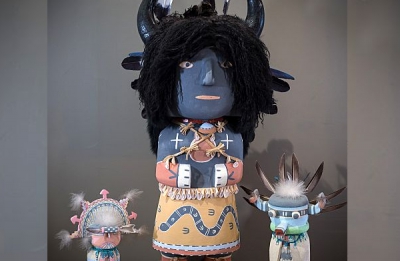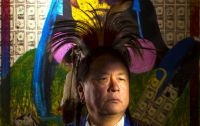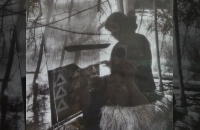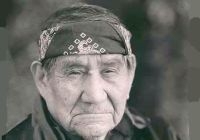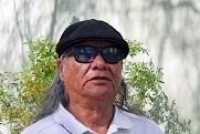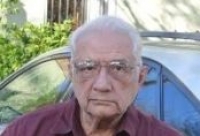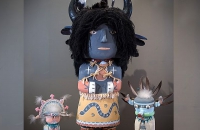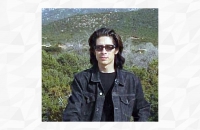A 3rd Mesa Hopi artist from the Hopi village of Hotevilla, this noted carver is deeply respectful of the traditions of his people. His kachinas are carved from dead cottonwood root and are in the same style used by the Hopi people for past centuries. His tools are a flint knife and a potter’s polishing stone. Using old techniques, he makes natural vegetal dyes and mineral paints made of copper, choke cherry berries, alkaline, jet and coal ash for color and adding a temper to resist fading over time. With angola goat hair, doeskin and duck feathers, he completes the kachina. These katsina are the type still carved for Hopi children today and can stand alone or be hung on the wall.
He is a well-known carver whose work is enthusiastically sought after by collectors around the world. Barry Goldwater collected pieces by Chester’s father which he donated to the Heard Museum. Other collectors include: President George Bush, Lorne Greene, Wayne Newton, Larry Hageman, R.C.Gorman, the Bass Brothers of Texas, the late gallerist Elaine Horwich and Anselm Bischoff of Bischoff’s Gallery. Mr. Poleyestewa maintains close relationships with many collectors: one Wyoming rancher opens his property to Chester for harvesting the cottonwood, another collector raises exotic birds such as macaws and parrots and sends him naturally shed, legal feathers.
Kachina dolls were and are made by Hopi uncles and fathers for their daughters and nieces so they would learn to recognize the dancers' masks during ceremonies, and the lore behind them. In the Hopi culture, which is matrilineal, the one thing the women are not permitted to do is to participate in Kachina ceremonies and dances in the Kivas although it is the aunts who teach the nieces and nephews the specific characters and their importance in the ceremonies. In fact, in Hopi dances, female Kachinas are actually represented by male dancers. The women are not allowed to take part in the kiva and dance ceremonies where the men lend their bodies to the spirit of the Katsinas, dress as the spiritual beings and perform exact dances that have been passed down for centuries to bring blessings to the people.
Primarily, the doll is hung on the wall or from the rafters of the house so that it may be seen at all times. Putting away the dolls so they are not damaged also teaches respect for the child’s belongings. The term ”kachina” refers to the mask dancer in the Pueblo village, or to the Spirit, which the dancer impersonates. Even though the painting of the costume and the body of the doll is important, it was the accuracy of the mask features that had to be as perfect as possible. This may explain why the earlier dolls were accurate in detailed outline, often with mere suggestions of arms and legs.
Katsinas were meant to be toys, as well as learning tools, so Poleyestewa's versions are adorable, seemingly cuddly, and very appealing - even the ogres. Another feature of his instantly recognizable style is the use of natural earth colors, which coat the underlying wood completely, and result in a soft, pastel-like palette unlike any other artist's.
Mr. Poleyestewa did not intend to follow in his father’s footsteps as a carver. He completed his studies at a Bureau of Indian Affairs school in Oklahoma then went on to Arizona State University to study communications and broadcast journalism. In a circuitous route he was lead back to his carving and his roots. None of his 3 sons carve and one is a broadcast journalist. Chester now enjoys the attention of his 13 grandchildren.
Bischoff’s Gallery is proud to represent these wonderful dolls and the gallery has the largest single display and offering of the 3foot to 4 foot kachinas as well as his smaller dolls.

